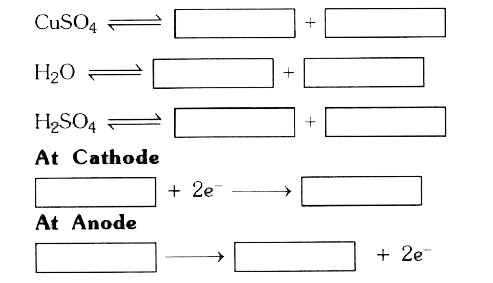The following questions refer to the electrolysis of copper sulphate solution using copper electrodes .
Compare the change in the mass of the cathode with the change in the mass of the anode .
To solve the question regarding the electrolysis of copper sulfate solution using copper electrodes, we will analyze the changes in mass at both the cathode and the anode.
1. Understanding Electrolysis:
- During electrolysis, an electric current is passed through the copper sulfate solution, which dissociates into copper ions (Cu²⁺) and sulfate ions (SO₄²⁻).
2. Identifying Electrodes:
- The electrode connected to the negative terminal of the battery is called the cathode, while the one connected to the positive terminal is called the anode. In this case, both electrodes are made of copper.
3. Reactions at the Cathode:
- At the cathode, copper ions (Cu²⁺) from the solution gain electrons (reduction) and are deposited as solid copper (Cu):
Cu2++2e−→Cu (s)
- This results in an increase in the mass of the cathode due to the deposition of copper.
4. Reactions at the Anode:
- At the anode, copper metal (Cu) loses electrons (oxidation) and goes into the solution as copper ions (Cu²⁺):
Cu (s)→Cu2++2e−
- This causes a decrease in the mass of the anode as copper is oxidized and enters the solution.
5. Comparison of Mass Changes:
- The mass of the cathode increases due to the deposition of copper, while the mass of the anode decreases as copper is oxidized and lost to the solution.
- The amount of copper deposited at the cathode is equal to the amount of copper lost from the anode, according to Faraday's laws of electrolysis. Therefore, the change in mass at the cathode is equal in magnitude but opposite in direction to the change in mass at the anode.
Conclusion:
- Mass of Cathode: Increases (due to copper deposition).
- Mass of Anode: Decreases (due to copper oxidation).
- The change in mass of the cathode is equal to the change in mass of the anode, but one is an increase and the other is a decrease.
- During electrolysis, an electric current is passed through the copper sulfate solution, which dissociates into copper ions (Cu²⁺) and sulfate ions (SO₄²⁻).
- The electrode connected to the negative terminal of the battery is called the cathode, while the one connected to the positive terminal is called the anode. In this case, both electrodes are made of copper.
- At the cathode, copper ions (Cu²⁺) from the solution gain electrons (reduction) and are deposited as solid copper (Cu):
Cu2++2e−→Cu (s)
- This results in an increase in the mass of the cathode due to the deposition of copper.
- At the anode, copper metal (Cu) loses electrons (oxidation) and goes into the solution as copper ions (Cu²⁺):
Cu (s)→Cu2++2e−
- This causes a decrease in the mass of the anode as copper is oxidized and enters the solution.
- The mass of the cathode increases due to the deposition of copper, while the mass of the anode decreases as copper is oxidized and lost to the solution.
- The amount of copper deposited at the cathode is equal to the amount of copper lost from the anode, according to Faraday's laws of electrolysis. Therefore, the change in mass at the cathode is equal in magnitude but opposite in direction to the change in mass at the anode.
- Mass of Cathode: Increases (due to copper deposition).
- Mass of Anode: Decreases (due to copper oxidation).
- The change in mass of the cathode is equal to the change in mass of the anode, but one is an increase and the other is a decrease.
Topper's Solved these Questions
- BOOK - ICSECHAPTER - ELECTROLYSISEXERCISE - QUESTION FOR PRACTICE ON EXAMINATION PATTERN39videos
ELECTROLYSIS
- BOOK - ICSECHAPTER - ELECTROLYSISEXERCISE - QUESTION3videos
ELECTROLYSIS
- BOOK - ICSECHAPTER - ELECTROLYSISEXERCISE - QUESTIONS (fill in the blanks )1videos
ELECTROLYSIS
- BOOK - ICSECHAPTER - CHEMISTRY-2015EXERCISE - SECTION-II (40 Marks) Attempt any four questions from this Section.49videos
CHEMISTRY-2015
- BOOK - ICSECHAPTER - METALLURGYEXERCISE - UNIT TEST PAPER 6 - Metallurgy (Select the correct answer from the list A,B,C & given in each statement.)5videos
METALLURGY
Similar Questions
Knowledge Check
- Question 1 - Select One
The ion which is discharged at the cathode during the electrolysis of copper sulphate solutions using copper electrodes an anode and cathode ?
ACu2+BOH−CSO2−4DH+
During the electrolysis of copper (II) sulphate solution using platinum as cathode and carbon as anode :
Write the reactions at the cathode and at the anode.View SolutionState the observations at the anode and at the cathode during the electrolysis of :
copper sulphate solution using copper electrodes.View SolutionDuring the electrolysis of copper (II) sulphate solution using platinum as cathode and carbon as anode :
What do you observe at the cathode and at the anode ?View SolutionDuring the electrolysis of copper (II) sulphate solution using platinum as cathode and carbon as anode :
What change is noticed in the electrolyte?View SolutionWrite the reactions at the cathode and at the anode during electrolysis of copper sulphate using copper electrode.
View SolutionDuring the electrolysis of copper (II) sulphate solution using platinum as cathode and carbon as anode :
What do you observe at the cathode and at the anode?View SolutionDuring electrolysis of an aqueous solution of CuSO4 using copper electrodes, if 2.5g of Cu is deposited at cathode, then at anode
View Solution


